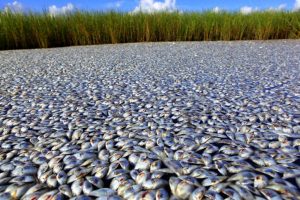Not everyone orders a steak and sits down to ponder the string of environmental detriments that one juicy filet caused. They are even less likely to consider the impacts of animal agriculture on a larger scale. Ifthey did, I think they would have opted for a salad instead.

Cows in an industrial feedlot Photo: Green Plains
Animal agriculture is now regarded as one of the biggest environmental issues affecting global sustainability and ocean health. According to the Food and Agriculture Organization of the United Nations , due to growing global populations and increased prosperity, people are consuming more meat and dairy products every year.
Global meat production is projected to more than double from 229 million tonnes in 1999/2001 to 465 million tonnes in 2050, while milk output is set to climb from 580 to 1043 million tonnes. (FAO)
Animal agriculture has been cited as the leading cause of:
- climate change
- deforestation
- species extinction
- water pollution
- oceanic dead zones
Livestock operations on land have created more than 500 nitrogen flooded dead zones around the world in our oceans.
What is a dead zone?
A “dead zone” is a more common term for hypoxia, which refers to a reduced level of oxygen in water.
The cause is usually eutrophication, or an increase of chemical nutrients, such as nitrogen and phosphorus, in the water, leading to harmful algae blooms that drastically deplete under water oxygen levels. As a result, coral reef systems collapse and many marine organisms unable to survive in these conditions must vacate or die, leaving behind a barren stretch of sea void of any signs of life.

Image from large scale fish deaths in the Louisiana dead zone. Photo: National Geographic
What is the connection between livestock and dead zones?
Improper disposal of nutrient rich livestock manure is a primary contributor to runoff. But manure isn’t the only culprit. The Food and Agriculture Organization (FAO) of the United Nations claims that other major livestock related polluting agents come from antibiotics and hormones, chemicals from tanneries, fertilizers and the pesticides used to spray feed crops. When all of these pollutants end up in the ocean, it creates a toxic concoction which triggers explosive algae blooms creating wide spread dead zones.
Do dead zones naturally occur?
Yes, historically many dead zone sites were naturally occurring as a result of cyclical nutrient upwelling and/or shifting of routine wind and water patterns. However, in the 1970s, oceanographers began noticing increasing instances and expanses of dead zones. Dead zone continue to appear worldwide at proliferating rates, world wide reported dead zones rose from 146 to 405 between the years 2004-2008. These fish-killing algae blooms wreak havoc on ocean ecosystems and local economies who depend on the sea as a source of income.
Dead zones are reversible

The Black Sea and surrounding landmass from above. Photo:Stuart Rankin.
The reversal of the colossal, 40,000 km2, dead zone in the NW shelf of the Black Sea is a remarkable success story in which the GEF, UNDP, and World Bank worked through a intricate partnership featuring UNDP regional projects and a World Bank Strategic Investment Fund.
Over 20 years, $386.46M of investment was put forth towards pollution-reduction measures. As a result, nitrogen and phosphorus emissions have fallen by 20% and 50% respectively over the last 15 years, and the number of recorded benthic species doubled between 1980 and 2000 (STAP, 2011). This was the first successful reversal of a man made dead zone, ever.
The projects reformed national agricultural policies, improved industrial an municipal wastewater treatment, rehabilitated ecosystems, and strengthened the region’s legislative framework and related enforcement. (GEF, 2015)
There is hope.
Ways you as an individual can avoid contributing to dead zones:
- Avoid purchasing animal products
- Support local famers
- Reduce your input of fertilizers and pesticides at home
- SPREAD AWARENESS

Reducing intake of animal products greatly reduces your ecological footprint. Photo: Clipart
References:
Rabotyagov SS. The Economics of Dead Zones: Causes, Impacts, Policy Challenges, and a Model of the Gulf of Mexico Hypoxic Zone. 2014:58-74.
Reich T. Dead Zone. Ploughshares. 2015;41(3):327-354.
Reversal of Dead Zone: Achieving the World’s First Reversal of a Dead Zone in the Black Sea. https://www.thegef.org/news/reversal-dead-zone-achieving-world’s-first-reversal-dead-zone-black-sea. Published January 29, 2018.
Shwartz M. Ocean ecosystems plagued by agricultural runoff. https://news.stanford.edu/news/2005/march16/gulf-030905.html. Published March 10, 2005.

No Comments so far ↓
There are no comments yet...Kick things off by filling out the form below.